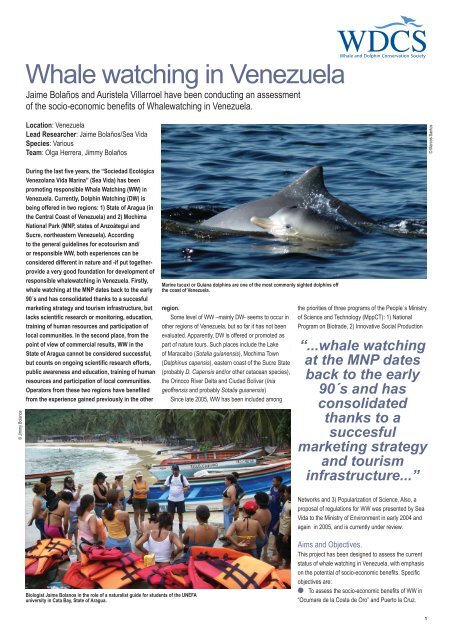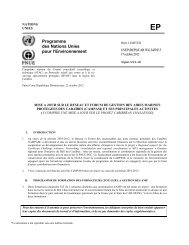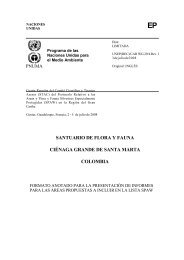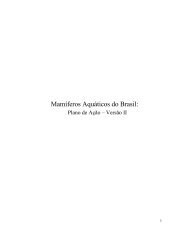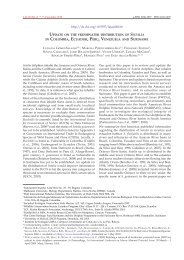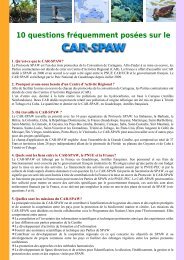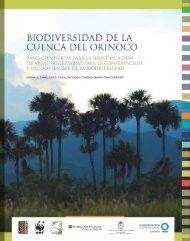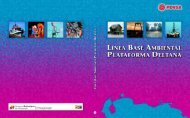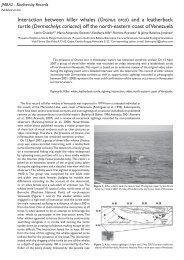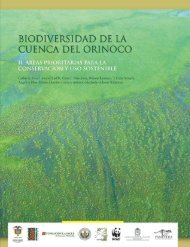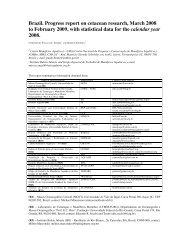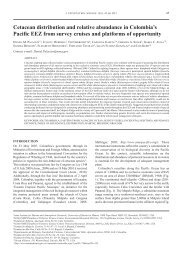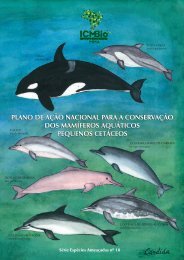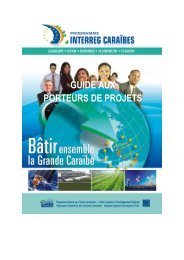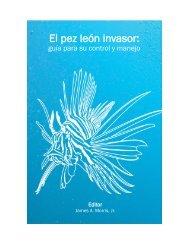You also want an ePaper? Increase the reach of your titles
YUMPU automatically turns print PDFs into web optimized ePapers that Google loves.
<strong>Whale</strong> <strong>watch<strong>in</strong>g</strong> <strong>in</strong> <strong>Venezuela</strong><br />
Jaime Bolaños and Auristela Villarroel have been conduct<strong>in</strong>g an assessment<br />
of the socio-economic benefits of <strong>Whale</strong><strong>watch<strong>in</strong>g</strong> <strong>in</strong> <strong>Venezuela</strong>.<br />
Location: <strong>Venezuela</strong><br />
Lead Researcher: Jaime Bolaños/Sea Vida<br />
Species: Various<br />
Team: Olga Herrera, Jimmy Bolaños<br />
© Marcos Santos<br />
© Jimmy Bolanos<br />
Dur<strong>in</strong>g the last five years, the “Sociedad Ecológica<br />
Venezolana Vida Mar<strong>in</strong>a” (Sea Vida) has been<br />
promot<strong>in</strong>g responsible <strong>Whale</strong> Watch<strong>in</strong>g (WW) <strong>in</strong><br />
<strong>Venezuela</strong>. Currently, Dolph<strong>in</strong> Watch<strong>in</strong>g (DW) is<br />
be<strong>in</strong>g offered <strong>in</strong> two regions: 1) State of Aragua (<strong>in</strong><br />
the Central Coast of <strong>Venezuela</strong>) and 2) Mochima<br />
National Park (MNP, states of Anzoátegui and<br />
Sucre, northeastern <strong>Venezuela</strong>). Accord<strong>in</strong>g<br />
to the general guidel<strong>in</strong>es for ecotourism and/<br />
or responsible WW, both experiences can be<br />
considered different <strong>in</strong> nature and -if put togetherprovide<br />
a very good foundation for development of<br />
responsible whale<strong>watch<strong>in</strong>g</strong> <strong>in</strong> <strong>Venezuela</strong>. Firstly,<br />
whale <strong>watch<strong>in</strong>g</strong> at the MNP dates back to the early<br />
90´s and has consolidated thanks to a succesful<br />
market<strong>in</strong>g strategy and tourism <strong>in</strong>frastructure, but<br />
lacks scientific research or monitor<strong>in</strong>g, education,<br />
tra<strong>in</strong><strong>in</strong>g of human resources and participation of<br />
local communities. In the second place, from the<br />
po<strong>in</strong>t of view of commercial results, WW <strong>in</strong> the<br />
State of Aragua cannot be considered successful,<br />
but counts on ongo<strong>in</strong>g scientific research efforts,<br />
public awareness and education, tra<strong>in</strong><strong>in</strong>g of human<br />
resources and participation of local communities.<br />
Operators from these two regions have benefited<br />
from the experience ga<strong>in</strong>ed previously <strong>in</strong> the other<br />
Mar<strong>in</strong>e tucuxi or Guiana dolph<strong>in</strong>s are one of the most commonly sighted dolph<strong>in</strong>s off<br />
the coast of <strong>Venezuela</strong>.<br />
region.<br />
Some level of WW –ma<strong>in</strong>ly DW- seems to occur <strong>in</strong><br />
other regions of <strong>Venezuela</strong>, but so far it has not been<br />
evaluated. Apparently, DW is offered or promoted as<br />
part of nature tours. Such places <strong>in</strong>clude the Lake<br />
of Maracaibo (Sotalia guianensis), Mochima Town<br />
(Delph<strong>in</strong>us capensis), eastern coast of the Sucre State<br />
(probably D. Capensis and/or other cetacean species),<br />
the Or<strong>in</strong>oco River Delta and Ciudad Bolívar (Inia<br />
geoffrensis and probably Sotalia guianensis)<br />
S<strong>in</strong>ce late 2005, WW has been <strong>in</strong>cluded among<br />
the priorities of three programs of the People´s M<strong>in</strong>istry<br />
of Science and Technology (MppCT): 1) National<br />
Program on Biotrade, 2) Innovative Social Production<br />
“...whale <strong>watch<strong>in</strong>g</strong><br />
at the MNP dates<br />
back to the early<br />
90´s and has<br />
consolidated<br />
thanks to a<br />
succesful<br />
market<strong>in</strong>g strategy<br />
and tourism<br />
<strong>in</strong>frastructure...”<br />
Networks and 3) Popularization of Science. Also, a<br />
proposal of regulations for WW was presented by Sea<br />
Vida to the M<strong>in</strong>istry of Environment <strong>in</strong> early 2004 and<br />
aga<strong>in</strong> <strong>in</strong> 2005, and is currently under review.<br />
Biologist Jaime Bolanos <strong>in</strong> the role of a naturalist guide for students of the UNEFA<br />
university <strong>in</strong> Cata Bay, State of Aragua.<br />
Aims and Objectives.<br />
This project has been designed to assess the current<br />
status of whale <strong>watch<strong>in</strong>g</strong> <strong>in</strong> <strong>Venezuela</strong>, with emphasis<br />
on the potential of socio-economic benefits. Specific<br />
objectives are:<br />
●● To assess the socio-economic benefits of WW <strong>in</strong><br />
“Ocumare de la Costa de Oro” and Puerto la Cruz.<br />
1
© Auristela Villarroel<br />
●● To ascerta<strong>in</strong> the level of WW <strong>in</strong> the Lake of<br />
Maracaibo (southern and northern tips, States of<br />
Merida and Zulia), Mochima Town, Rio Caribe Town<br />
(State of Sucre), Ciudad Bolívar (State of Bolivar) and<br />
Delta Amacuro.<br />
●● To provide authorities with elements to value<br />
the role of WW as a key element of management<br />
of biological diversity and development of local<br />
communities.<br />
Method<br />
Socio-economic benefits of WW will be evaluated<br />
and analysed accord<strong>in</strong>g to the questionnaire model<br />
developed by Hoyt (2001). The field work <strong>in</strong>cludes<br />
<strong>in</strong>terviews with local operators and governmental<br />
tourism management agencies <strong>in</strong> localities such as<br />
Maracaibo, Mérida, Ocumare de la Costa de Oro,<br />
Puerto la Cruz, Mochima, Río Caribe, Delta Amacuro<br />
and Ciudad Bolívar. When possible, as it is the case <strong>in</strong><br />
Puerto la Cruz city and Mochima Town, opportunistic<br />
surveys will be made aboard commercial trips to<br />
collect <strong>in</strong>formation on dolph<strong>in</strong> sight<strong>in</strong>gs.<br />
In the short-medium term, it is expected that<br />
<strong>in</strong>creased awareness and support from authorities<br />
(M<strong>in</strong>istries and regional agencies of Science and<br />
Technology, Environment and Tourism, respectively)<br />
would be capital for consolidation of responsible WW<br />
<strong>in</strong> these and other regions of the country.<br />
Update from the Field<br />
Between November 2007-January 2008, field trips<br />
were made to north-eastern and north-western<br />
<strong>Venezuela</strong> to <strong>in</strong>terview and present the questionnaire<br />
to local tour operators. Up to now, locations visited<br />
<strong>in</strong>clude Bahia de Cata (State of Aragua), Puerto la<br />
Cruz (State of Anzoátegui), Cumaná city and Mochima<br />
Town (State of Sucre), Maracaibo (State of Zulia)<br />
and Mérida (State of Mérida). Questionnaires were<br />
also sent to 12 tour operators <strong>in</strong> the State of Bolívar.<br />
The names and addresses of several operators were<br />
searched previously <strong>in</strong> the <strong>in</strong>ternet.<br />
Results<br />
●● Accord<strong>in</strong>g to results, at least 9000 tourists went<br />
dolph<strong>in</strong> <strong>watch<strong>in</strong>g</strong> <strong>in</strong> <strong>Venezuela</strong>, dur<strong>in</strong>g 2007. Regions<br />
visited by tourists <strong>in</strong>clude the States of Aragua,<br />
Fisherman Mr Jose (“Cata”) Diaz complet<strong>in</strong>g his<br />
questionnaire.<br />
Expla<strong>in</strong><strong>in</strong>g the project to owners and personel from Tyllandsia Tours, city of Merida,<br />
State of Merida.<br />
Anzoátegui, Apure, Bolívar, Mérida, Sucre and Zulia.<br />
●● Total expenditures were approx. BsF 1.5 million<br />
(approx. US$ 700.000).<br />
●● In Aragua, Anzoátegui, Bolívar and Sucre States,<br />
more than 90% of visitors were <strong>Venezuela</strong>ns. In the<br />
States of Apure, Mérida and Zulia, more than 90%<br />
were europeans.<br />
●● Several tour operators <strong>in</strong> the States of Anzoátegui,<br />
Mérida, Sucre and Zulia count on more than 20 years<br />
“Total [whale<br />
<strong>watch<strong>in</strong>g</strong>]<br />
expenditures<br />
were...$700,000”<br />
of experience.<br />
Conclusions:<br />
1. Dolph<strong>in</strong>-<strong>watch<strong>in</strong>g</strong> <strong>in</strong> <strong>Venezuela</strong> is more<br />
widespread than previously thought.<br />
2. Dolph<strong>in</strong>-<strong>watch<strong>in</strong>g</strong> <strong>in</strong> <strong>Venezuela</strong> <strong>in</strong>cludes both<br />
mar<strong>in</strong>e and freshwater species.<br />
3. Dolph<strong>in</strong>-<strong>watch<strong>in</strong>g</strong> has been offered dur<strong>in</strong>g,<br />
at least, the last 20-25 years <strong>in</strong> several regions of<br />
<strong>Venezuela</strong>.<br />
4. Only <strong>in</strong> Aragua dolph<strong>in</strong>-<strong>watch<strong>in</strong>g</strong> operations have<br />
been preceded by scientific research.<br />
5. Because of the lack of several key components,<br />
dolph<strong>in</strong>-<strong>watch<strong>in</strong>g</strong> operations <strong>in</strong> the states of Apure,<br />
Anzoátegui, Bolívar, Mérida, Sucre and Zulia cannot<br />
be considered susta<strong>in</strong>able.<br />
Recomendations:<br />
●● Current commercial operations <strong>in</strong> the states of<br />
Apure, Anzoátegui, Mérida, Nueva Esparta, Sucre<br />
and Zulia should be evaluated and supervised by<br />
<strong>in</strong>terested parties and relevant authorities. Accord<strong>in</strong>g<br />
to <strong>Venezuela</strong>n regulations, it should be a “Specific<br />
Environmental Evaluation” or “Environmental Impact<br />
Assessment”.<br />
●● We recommend the design and development of<br />
a “National Strategy for development of responsible<br />
whale<strong>watch<strong>in</strong>g</strong>”.<br />
●● Because of the importance of participation of such<br />
authorities as the M<strong>in</strong>istries of Environment, Science<br />
and Technology and Tourism, the regulatory <strong>in</strong>strument<br />
to be promoted should be a Presidential Decree.<br />
The results of this project have been very timely<br />
and valuable for the Lat<strong>in</strong> America <strong>Whale</strong> Watch<br />
Report by Hoyt and Iñíguez (2008) as it has helped<br />
to add depth to their comparative analysis for<br />
whale<strong>watch<strong>in</strong>g</strong> activities <strong>in</strong> <strong>Venezuela</strong>, see website l<strong>in</strong>k<br />
below for further <strong>in</strong>formation:<br />
http://www.wdcs-de.org/docs/WW_Lat<strong>in</strong>america_<br />
English.pdf<br />
© WDCS<br />
Created by WDCS UK<br />
Brookfield House, 38 St Paul Street,<br />
Chippenham, SN15 1LJ<br />
T: +44 (0)1249 449500<br />
Registered charity no: 1014705<br />
www.wdcs.org<br />
Offices <strong>in</strong> Argent<strong>in</strong>a, Australia, Germany, UK and USA<br />
© Jimmy Bolanos<br />
2


